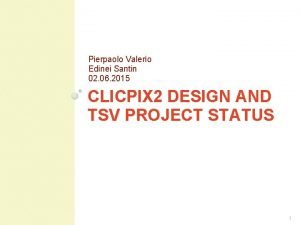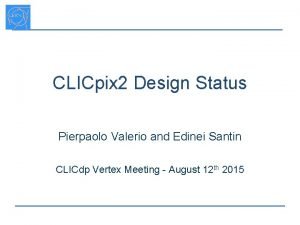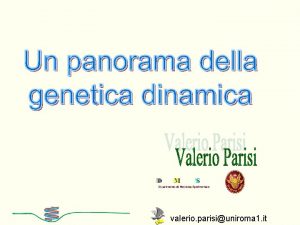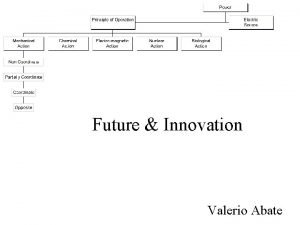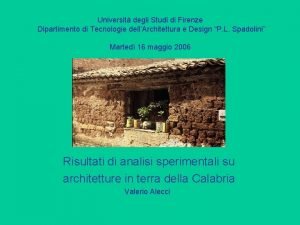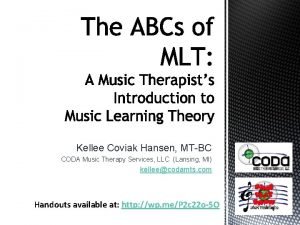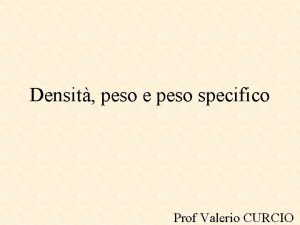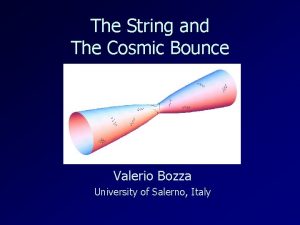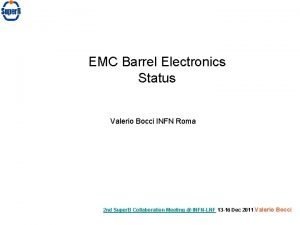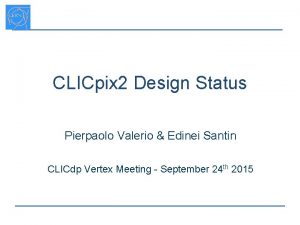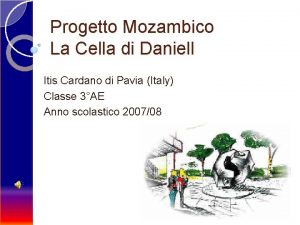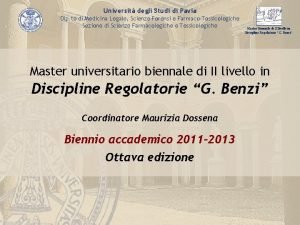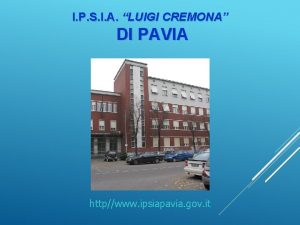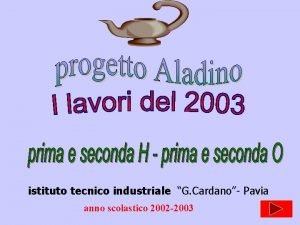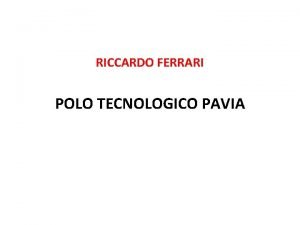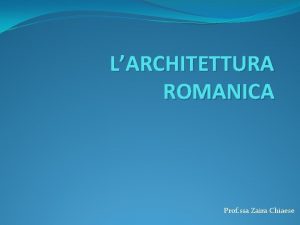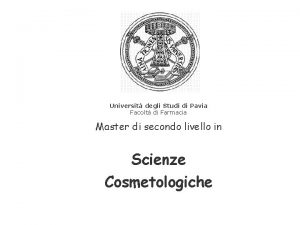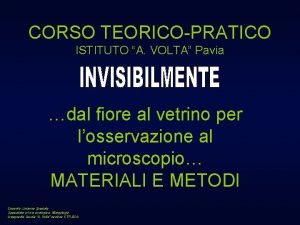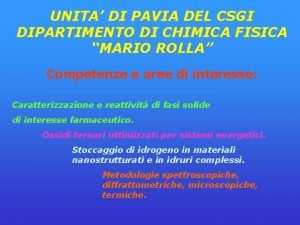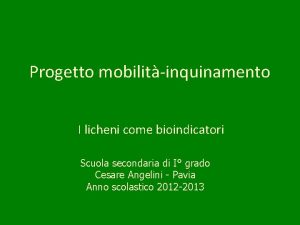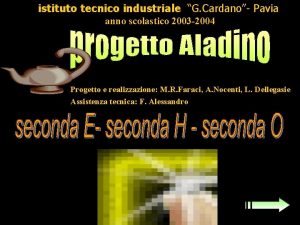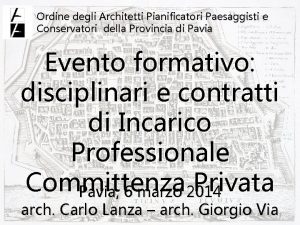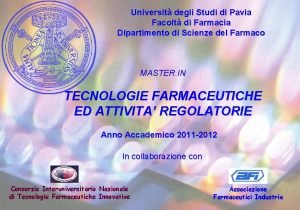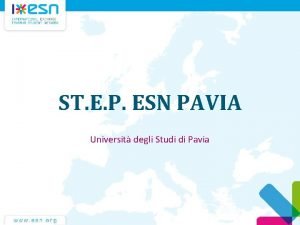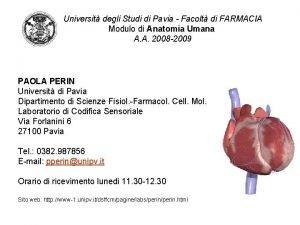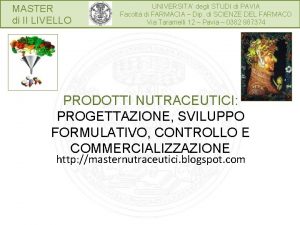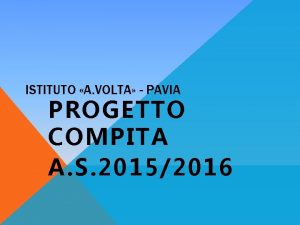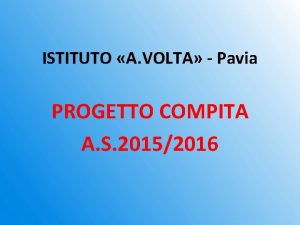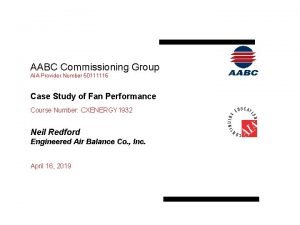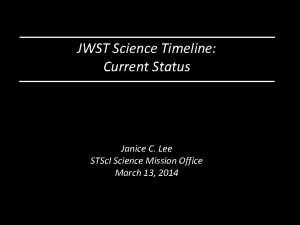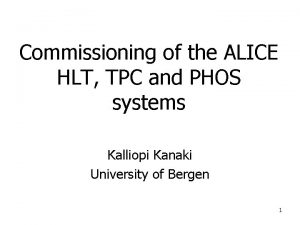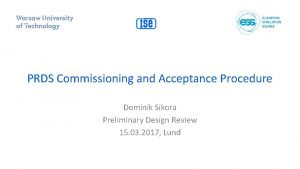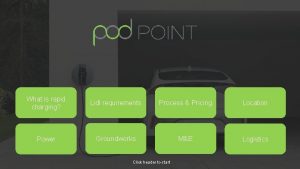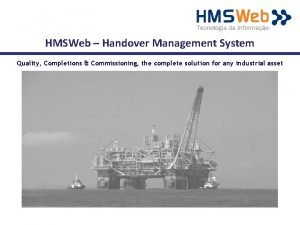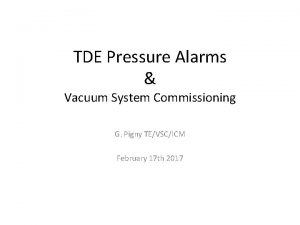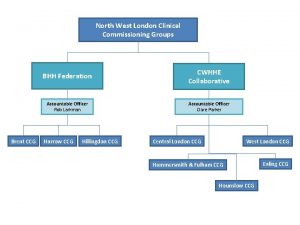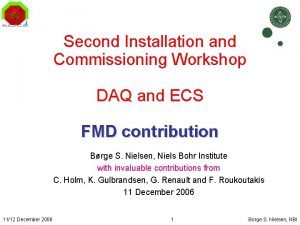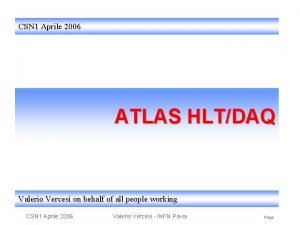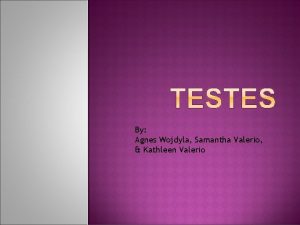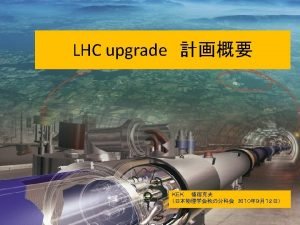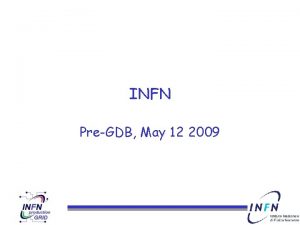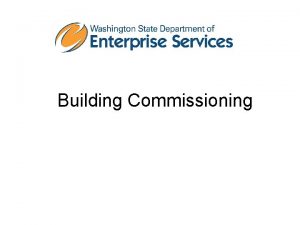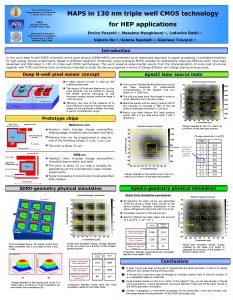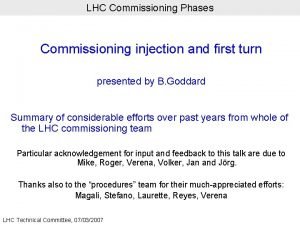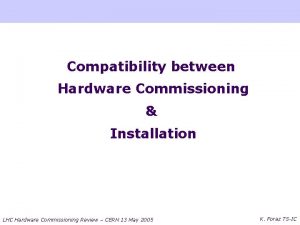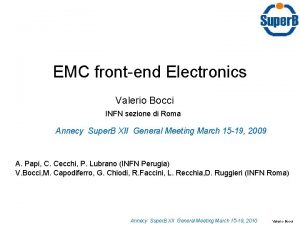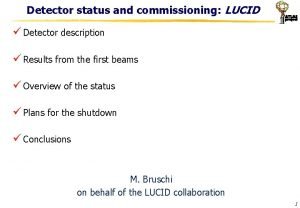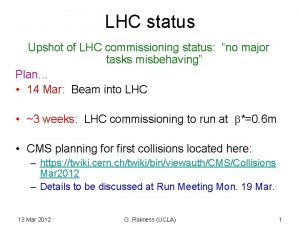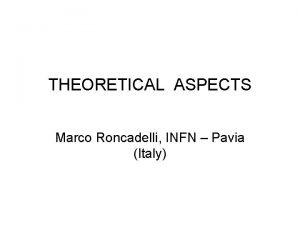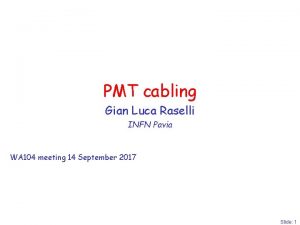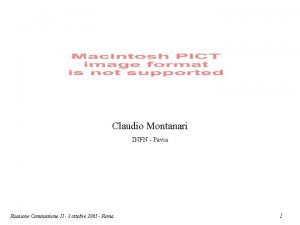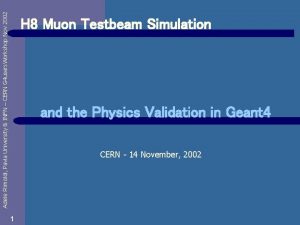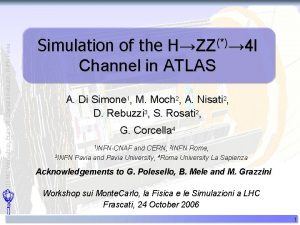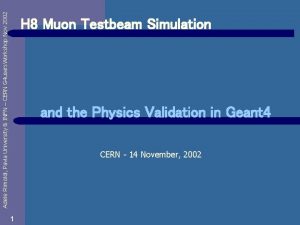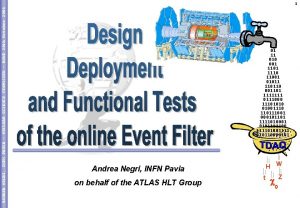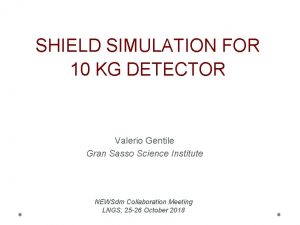Detector Commissioning Valerio Vercesi INFN Pavia ItaloHellenic LHC

















































- Slides: 49

Detector Commissioning Valerio Vercesi – INFN Pavia Italo-Hellenic LHC School of Physics 2004 LHC School 2004 Valerio Vercesi - INFN Pavia

Many thanks to all friends and colleagues of CMS and ATLAS who have contributed (aware or unaware) to the following In particular M. Boonekamp, S. Cittolin, F. Gianotti, R. Mc. Pherson, L. Mapelli, P. Nevski, L. Nisati, J. Proudfoot, P. Sphicas, S. Tapprogge Most of the examples given for ATLAS, approach valid for both experiments LHC School 2004 Valerio Vercesi - INFN Pavia 2

Commissioning thoughts What do we mean by “commissioning CMS/ATLAS? ” Slow Control Local DAQ Magnets …. EM Calo electronics Detector cooling Access tests Had Calo RO First beams Cryo tests Cosmic data LVL 1 muons Control room LVL 1 timing ………. … and many more! LHC School 2004 Valerio Vercesi - INFN Pavia 3

Installation… LHC School 2004 Valerio Vercesi - INFN Pavia 4

CMS parameters Detector Channels Control Ev. Data Pixel Tracker Preshower ECAL HCAL Muon DT Muon RPC Muon CSC Trigger 60000000 145000 85000 14000 200000 400000 Event size Max LV 1 Trigger Online rejection System dead time LHC School 2004 Valerio Vercesi - INFN Pavia 1 GB 10 MB 100 k. B 10 MB 1 GB 50 (k. B) 650 50 10 5 90 16 1 Mbyte 100 k. Hz 99. 999% ~% 5

ATLAS parameters Inner detector Channels No. ROLs Fragment size - k. B Pixels 1. 4 x 10 8 120 0. 5 SCT 6. 2 x 10 6 92 1. 2 TRT 3. 7 x 10 5 256 1. 2 ATLAS total event size = 1. 5 MB Total no. ROLs = 1628 Calorimetry Channels No. ROLs Fragment size - k. B LAr 1. 8 x 10 5 768 0. 75 Tile 104 64 0. 75 Muon system Channels No. ROLs Fragment size - k. B MDT 3. 7 x 10 5 192 0. 8 CSC 6. 7 x 10 4 32 0. 8 RPC 3. 5 x 10 5 32 0. 38 TGC 4. 4 x 10 5 16 0. 38 Trigger Channels LVL 1 No. ROLs Fragment size - k. B 56 0. 5 ROL = Read Out Link = Point-to-point ROD-ROB Connection LHC School 2004 Valerio Vercesi - INFN Pavia 6

Commissioning organization v The commissioning process is complex and must interleave many competing tasks. It must therefore be carefully conceived and organized v Experiments are pushed to do so also from outside e. g. by the LHCC… v It must be based on the principle that the various components have to be commissioned as soon as possible and as much it is possible without beam It will be a long learning process v Commissioning will be running in parallel to the detector installation work v Detector commissioning is a job that involves the entire detector and physics communities This needs to be coordinated LHC School 2004 Valerio Vercesi - INFN Pavia 7

CDF Run II v CDF kept the solenoid, central calorimeter and part of the muon system v Everything else (tracker, silicon detectors, electronics, etc. ) is new Fortran C++ ( ) Fastbus VME 1. 5 ms readout 132 ns pipelined readout New Trigger and DAQ hardware New Event Data Model for reconstruction and Level 3 filters LHC School 2004 Valerio Vercesi - INFN Pavia 8

Commissioning CDF v Timeline from 1999 to 2002 2 “false starts” to form commissioning organization Started in earnest in late 1999 Engineering run in Oct 2000 • Missing sections of electronics and detector systems • Only simple trigger capability Physics commissioning started spring 2001 • Missing hardware • Hardware problems on the detector • Inadequate/missing software and software tools • Unreliable DAQ system (software & hardware) Major shutdown and detector repairs in Oct 2001 • Many hardware problems fixed • Improved software and tools to basic capability • Began commissioning 2 nd Level trigger Physics quality data established Mar 2002 • Then began a steady grind to improve data quality and data-taking efficiency LHC School 2004 Valerio Vercesi - INFN Pavia 9

CDF Commissioning Organization Spokesmen Executive Board Al Goshaw Nigel Lockyer Detector and Computing operations Offline Analysis Head 1: P. Savard Dep. Head: M. Lindgren Dep. Head: R. Roser Dep. Head: R. Harris Detector Subsystems Assoc. Head: J. Proudfoot Silicon Comp. Infrastructure Assoc. Head: F. Wurthwein Data Handling COT Farms TOF Calorimeter Muon CAF CLC Data. Base Validation: -Release -Production -R. Snihur Trailer Computing Detector Operations Assoc. Head: K. Maeshima Head 2: A. Yagil Infrastructure: -AC++ -EDM -I/O -Data format L. Sexton-Kennedy Muons V. Martin D. Dagenhart B/C Physics K. Pitts C. Paus Tracking M. Herndon C. Hays Electroweak A. Kotwal P. Murat Electrons, jets, calor B. Heinneman B. Wagner Exotics S. Lammel S. Worm Detector Infrastructure Assoc. Head: S. Moccia Process Systems Electrical & Mechanical Slow controls Building Manager LHC School 2004 Run 2 B Project (P. Lukens, Proj. Mgr. ) D. Benjamin (Deputy) Project Office D. Knapp, T. J. Sarlina Silicon N. Bacchetta B. Flaugher Calorimetry S. Kuhlmann Simulation M. Shapiro M. Paulini Trigger Sim S. Rolli DAQ/Bandwidth K. Pitts QCD J. Dittman M. Martinez Top P. Azzi J. Konigsberg Speakers Committee Chair: J. Conway Monitors Forward Physics Coordinator T. Liss Production exe Prod. Coord. Data Base DAQ Trigger Code management Releases A. Kreymer Trigger Data. Set Working Group Chair: J. Lewis, L. Ristori Ops Managers Daily/Weekly ops Shift Crews- Sci. Co, CO, Aces(2) Statistics Committee Chair: L. Lyons Calibrations Web Development NA Offline Operations Assoc. Head: P. Murat Godparents Offline Aces Offline Shifters Valerio Vercesi - INFN Pavia 10

A walk through CDF Run 2 history v Problems getting the detector ready for the “Engineering Run ”: from fall 1999 – Oct 2000 Late delivery of readout electronics (some not even making it in time) Continual development of the DAQ software Unreliable DAQ hardware as more front end boards and crates were integrated into the overall system Unreliable slow controls and monitor system Establishment of basic calibration infrastructure (calibration software, database, evaluation software and presenter) Lack of 2 nd level trigger and a trigger system interface that was singularly difficult to use v Ran shifts, took calibrations and cosmic ray runs routinely but Didn’t have very user friendly software to know if the detector was performing well Only could have a limited plan as to what to do once things went awry. Since only experts could fix things, when the system failed on the owl shift you were dead in the water Burned up people, experts and motivation. But the detector took data in the engineering run and we learned about all of the additional work that was to be needed before physics quality data could be recorded LHC School 2004 Valerio Vercesi - INFN Pavia 11

2001: The Odyssey continues… v Fix noise in parts of readout (which in one case required designing v v v v and building small auxiliary boards and installing them on the detector) Add shielding for the muon system Install silicon detector (and think about how to fix the cooling system problem) Test Level 2 system (and in particular design a new backplane to deal with bus arbitration problems) and the several interface boards Finally got some decent amount of beam and came to a grinding halt with a single beam incident in which many power supplies failed simultaneously Continue working on all sorts of software: monitoring, database, reconstruction, filter algorithms to handle the fact that we had no level 2…. . Tried hard to take physics data when there was beam, but it was compromised by holes in the detector readout (especially in the tracking detectors) Continued burning up people, experts and motivation…. LHC School 2004 Valerio Vercesi - INFN Pavia 12

What were the hardest problems? A dysfunctional accelerator Establishing the PLAN and PRIORITIES for the detector as a WHOLE Power supply reliability and performance (e. g. noise) Incremental commissioning as readout is added to a specific system – this causes a lot of unnecessary repeated work v Basic design or fabrication errors v v Blocked cooling lines in the silicon system Resonance excitation of silicon traces on the front end boards v Optimization of the silicon readout and SVT trigger v Commissioning the TRIGGER L 2 decision crate with custom backplane L 2 interface boards built to a common specification but with many different implementations Bandwidth (performance not meeting expectations, also a failure to establish a clear specification) L 3 software to respond to unexpected conditions (higher trigger rates, no Level 2 etc. ) v Beam induced problems SEU’s in control units, FPGA’s Potentially dangerous currents in the silicon readout Development of beam monitoring and detector protection code LHC School 2004 Valerio Vercesi - INFN Pavia 13

Lessons learnt v Organization and management has been key to realizing successful and efficient CDF detector operations v Components arriving later than scheduled impact the commissioning of the entire detector system v The trigger and data acquisition systems are essential. Commissioning the 2 nd level trigger while trying to take physics data was painful and cost a modest amount of physics data (note this is not much different from staging) v Software is the principal way to interact with the detector readout and probably the only way when the detector is closed. If one has to develop these tools while commissioning the detector then the work proceeds slowly and painfully LHC School 2004 Valerio Vercesi - INFN Pavia 14

Commissioning in steps @ LHC Phase A System commissioning to ROD level. System commissioning for LVL 1 and DAQ Check cable connections. Infrastructure commissioning (refrigerators, water cooling, etc. ) Phase B ROD – Local DAQ connections established. Calibration runs on local systems. Skeleton TTC system needs to be available. Phase C System/Trigger/DAQ combined commissioning Phase D Global commissioning cosmic ray runs, planning for initial physics runs; initial off-line analysis software available, first collisions 1/03 LHC School 2004 03/04 08/06 Valerio Vercesi - INFN Pavia 11/06 15

ATLAS cavern layout LHC School 2004 Valerio Vercesi - INFN Pavia 16

Cosmic Muons in ATLAS Concrete Air Surface building PX 14/16 shielding (2. 5 g/cm 3) PX 16 PX 14 (12. 6 m Inner Ø ) (18. 0 m Inner Ø) ATLAS Rock ~ Silicon Geant 3 Simulation Initial detector 600 m x 200 m deep (2. 33 g/cm 3) LHC School 2004 Valerio Vercesi - INFN Pavia 17

Expected rates of cosmic muons Condition Rate (Hz) Esurface> 10 Ge. V (PDG generator) Esurface>10 Ge. V (ALEPH generator) ATLAS UX 15 -- 5900 4900 Any G 3 digit -- 2800 2300 Through RPCY>0 x RPCY<0 x IDDIGI 28 24 going RPCY>0 x RPCY<0 x PIXDIGI 0. 6 0. 4 Pass by |ZDIGI| < 300, |RDIGI| < 60 cm 12. 2 10. 2 origin |ZDIGI| < 100, |RDIGI| < 30 cm 2. 3 1. 9 |ZDIGI| < 60, 0. 6 0. 5 > 5 Ge. V 0. 1 ETCLUSTER > 5 Ge. V 0. 2 ETTOTAL > 5 Ge. V 0. 4 Tile Cal ETOTAL > 20 Ge. V 1. 4 1. 2 HEC ETOTAL > 20 Ge. V 0. 1 FCAL ETOTAL > 20 Ge. V 0. 02 ETCELL EM Cal |RDIGI| < 20 cm Two generators (nominal B fields), one based on PDG approximation, the other on ALEPH measurements Agreement 20% level between 2 generators, with the PDG overestimating the low energy flux LHC School 2004 Valerio Vercesi - INFN Pavia 18

Muon flux measurements Telescope ~ 1000 cm 2 DATA MC PX 14 LHC School 2004 PX 16 Data ~ 1. 5×simulatiom Constant 2. 33 g/cm 3 rock density used in simulation might explain the difference Using simulation should give conservative rates Valerio Vercesi - INFN Pavia 19

Cosmic Muons in ATLAS in 0. 01 s… LHC School 2004 Valerio Vercesi - INFN Pavia 20

Typical cosmic events… v One track reconstructed in Muon chambers v Two tracks reconstructed in Inner Detector v Will happen every ~ 10 s LHC School 2004 Valerio Vercesi - INFN Pavia 21

Muon momentum distributions LHC School 2004 Valerio Vercesi - INFN Pavia 22

Beam halo vs Beam-gas § Beam-halo § Simulation of accelerator background performed by V. Talanov et al. § based on MARS: machine optics V 6. 4 § nominal high-luminosity: beam current: 530 m. A § scoring plane at the cavern entrance before ATLAS shielding (|z|=23 m from IP) § Particles are then transported by ATLAS full (G 3) simulation Scoring plane Beam-Halo • Beam-Halo LHC School 2004 Beam-gas Beam-Gas – p(7 Te. V) on p(rest) – vertices uniformly distributed over 23 m – (p. H, p. C, p. O, …) (pp)×A 0. 7 (inelastic only) – vacuum estimate: ~3. 10 -8 torr (~1015 mol/m 3) Valerio Vercesi - INFN Pavia 23

Example of beam-halo muons LHC School 2004 Valerio Vercesi - INFN Pavia 24

Beam-halo expected rates Particle Rate @ cavern entrance (single-beam period) Particle Rate @ cavern entrance (standard operation) All ~10 k. Hz All 1750 k. Hz h± ~8 k. Hz h± 1515 k. Hz n ~0. 7 k. Hz n 130 k. Hz ~0. 5 k. Hz 105 k. Hz , E>10 Ge. V ~100 Hz , E>10 Ge. V 16 k. Hz , E>0. 1 Te. V ~5 Hz , E>0. 1 Te. V 1 k. Hz , E>1 Te. V 10 Hz , E>1 Te. V LHC School 2004 ~0. 5 Hz Valerio Vercesi - INFN Pavia 25

Beam-halo expected rates v Rates for initial period scaled from high-luminosity rates by assuming 3 x 1010 p per bunch and 43 bunches ~ 200 times lower current v Expected optics and vacuum for commissioning period not included yet (need input from machine people) these results are very preliminary v Total rates are for two months of single-beam with 30% data taking efficiency v Simple definition of “useful tracks” : 2 -3 segments in MDT, 3 -4 disks in ID end-ca Ve Detector MDT barrel MDT end-cap Pixel/SCT EM E > 5 Ge. V Tile/HEC Rate (B-field off ) Total (B-field off) Rate (B-field on) ry pre lim Total (B-field on) ina r 15 Hz 2. 5 107 72 Hz 1. 5 108 145 Hz 2. 5 108 135 Hz 2. 5 108 1. 8/17 Hz 3 106 / 3 107 2/19 Hz 3 106 / 3 107 2 Hz 3. 5 106 1 Hz 1. 7 106 1. 7/1. 2 Hz 2. 9/2. 1 106 1. 6/0. 9 Hz 2. 8/1. 6 106 y E > 20 Ge. V LHC School 2004 Valerio Vercesi - INFN Pavia 26

A typical beam-gas event Beam-gas collisions are essentially boosted minimum-bias events low-p. T particles Rate : ~ 2500 interactions/m/s LHC School 2004 Valerio Vercesi - INFN Pavia 27

Beam-gas rates in ATLAS Vertex z-position Rate (Hz) Total (2 months, =30%) 23 m 3 m 20 cm 1. 2 105 1. 6 104 1. 1 103 2. 1 1011 2. 4 1010 1. 6 109 p. T > 1 Ge. V 1. 0 103 1. 5 109 p. T > 1 Ge. V 0. 3 103 5. 6 108 inside 3 m ET spectrum in ECAL LHC School 2004 Valerio Vercesi - INFN Pavia ET charged particles E spectrum in FCAL 28

Trigger issues • How to trigger on cosmics, beam-halo and beam-gas ? Cosmics : RPC Beam-halo : TGC Beam-gas : ? ? ? … v From preliminary full simulations of LVL 1 Cosmics: ~ 100 Hz pass low-p. T RPC LVL 1 Beam-halo: ~ 1 Hz pass low-p. T TGC LVL 1 Small enough • not worrying for LHC physics data taking High enough • Useful samples (e. g. > 108 cosmics events in 3 months if =50%) for detector commissioning (these triggered muons cross the interaction region) v Beam-gas trigger Soft particles: not obvious… Scintillator slabs in front of FCAL Useful also for beam-halo at low R and for minimum bias trigger during initial collision period LHC School 2004 Valerio Vercesi - INFN Pavia 29

Increase cosmics trigger acceptance v Exciting last opportunity! After that, one will only be asked to reduce trigger rates… v Muon system Requirement for cosmics and beam-halo triggers included in design: • e. g. trigger ASICs include programmable delays to compensate for TOF of down-going cosmic-ray muons in barrel Projectivity constraints result from cabling between planes of trigger chambers Lot of flexibility in the system • Timing adjustments • Open L 1 roads • Relax coincidence requests At LVL 2 modified trigger algorithms can help in selecting non-pointing muons v Tile Calorimeter system RPC commissioned end 2005 December 2004 : Tilecal in the pit equipped with electronic • commissioning with cosmics can start • need self-triggering scheme while waiting for RPC consider back-to-back trigger towers ( x =0. 1 x 0. 1, full calo depth) • ask E > 1. 5 Ge. V in both towers • Expected rate from full simulation : ~ 130 /hr for 16 top+16 bottom modules LHC School 2004 Valerio Vercesi - INFN Pavia 30

Tile. Cal based cosmic trigger -distribution of muons passing Tilecal trigger LHC School 2004 Valerio Vercesi - INFN Pavia 31

Spectrometer commissioning v All sub-detectors will profit from cosmics data taking period Sub-detector commissioning starts with installation (Phase A) A case study for Muon Spectrometer v Cosmic rate high enough for polar angles up to q=75 o: ~1 Hz/strad for muons going through the ID (almost projective) and p >10 Ge. V Study of all barrel sectors (probably except sectors 1 -9 with vertical chambers) and part of the forward chambers (EI/CSC-EM or EM-EO tracks, probably no EI-EM-EO tracks) v First test of the full reconstruction (field off/reduced/full field) v Map dead channels, chase/replace faulty FE cards v Tube efficiency, r-t relation (autocalibration): 1000 (no field)-10000 (with field) muons/tube => ~10 -100 days v Check/calibration of the (barrel only? ) alignment system with straight tracks (<30 m level): 2000 muons/chamber ~10 hours v Alignment ( Barrel / End cap), ( Spectrometer / ID) v A large part of the muon spectrometer commissioning can be done with cosmics, provided a proper trigger is available LHC School 2004 Valerio Vercesi - INFN Pavia 32

Commissioning ECAL Barrel middle compartment Test-beam data Rate of cosmic muons (with |z|<30 cm and giving Ecell>100 Me. V) per cell of ECAL middle compartment vs , S( )/N 7 Rate needed to collect ~ 100 /cell over 3 months assuming 50% data taking efficiency 100 muons per cell over | | <=1 and 70 % of coverage LHC School 2004 Valerio Vercesi - INFN Pavia 33

ECAL with cosmics • With 100 muons /cell /compartment • • • check calorimeter timing to < 1 ns input to optimal filtering in ROD check calorimeter position in / wrt other sub-detectors to < 1 mm check response uniformity vs : 0. 5% precision could be achieved Test-beam data 1% precision measured with ~1000 with ~ 5000 : 0. 5 % precision (~ 100 /cell integrated over ) Muons E~300 Me. V t ~ 6 ns t = 1. 62 ns/E (Ge. V) 19 ps (from calibration) LHC School 2004 Valerio Vercesi - INFN Pavia 34

Commissioning Inner Detectors Cosmics : Reconstructed of cosmics ℴ(1 Hz) tracks in Pixels+SCT+TRT • useful statistics for debugging readout, maps of dead modules, etc. • check relative position Pixels/SCT/TRT and of ID wrt ECAL and Muon Spectrometer • first alignment studies: may achieve statistical precision of ~ 10 m in parts of Pixels/SCT • first calibration of R-t relation in straws of beam-gas tracks Beam-gas : ~ 25 Hz of reconstructed tracks with p. T > 1 Ge. V and |z|<20 cm • >107 tracks (similar to LHC events) in 2 months • enough statistics for alignment in “relaxed” environment • exceed initial survey precision of 10 -100 m LHC School 2004 Valerio Vercesi - INFN Pavia 35

Control Room(s) v Points for consideration Operation organization inside the experiment CR hardware and software configuration & implementation Operations to be exported outside Point 1 v Operation of the detector Control and monitoring of the experiment with and without beam v Control & Monitoring of the experimental area Access and general safety Interaction with Technical Coordination and other CRs at CERN v Collaborative aspects “Heart of experiment” To become (after detector commissioning) experiment centred v How to organize Operations in the context of the control room Continuity of responsibility Authority Availability of people v Outreach aspects Visitor “gallery” Experiment operations simulator LHC School 2004 Valerio Vercesi - INFN Pavia 36

For example… LHC School 2004 Valerio Vercesi - INFN Pavia 37

The Trigger v Anything done during commissioning and cosmic periods v v v needs a properly functional trigger However operation modes differ in the different data acquisition environments Depending on signal source need different timing for sub -detectors How to setup the trigger itself to be ready for the collision mode period? How detectors will be timed-in in order to make sure events will be properly assembled? How we can build a robust trigger selection, against variable background levels, data corruption, hardware failures? How can we have a redundant trigger and data acquisition structure to protect against data losses and dead time? LHC School 2004 Valerio Vercesi - INFN Pavia 38

CMS Architecture Collision rate Level-1 Maximum trigger rate Average event size ≈ Event Flow Control ≈ LHC School 2004 40 MHz 100 k. Hz 1 Mbyte 106 Msg/s No. of In-Out units Readout network bandwidth Event filter computing power Data production No. of PC motherboards Valerio Vercesi - INFN Pavia ≈ ≈ 512 1 Terabit/s 106 SI 95 Tbyte/day Thousands 39

ATLAS Architecture Trigger Calo Mu. Tr. Ch Other detectors 40 MHz DAQ 40 MHz Ro. I 2. 5 ms LVL 1 75 k. Hz Ro. I Builder ROIB L 2 SV Ro. I requests Event Filter EFP EFP L 2 N ~ sec ROB Read-Out Buffers EFN D ROD-ROS Merger A T Read-Out Sub-systems 3+3 GB/s A Dataflow Manager F Event Building N/work L O Sub-Farm Input W Event Filter N/work SFO Sub-Farm Output DFM EFacc = ~0. 2 k. Hz ~ 200 Hz LHC School 2004 ROD-ROB Connection ROS LVL 2 acc = 2. 5 k. Hz 120 GB/s RRC RRM L 2 P T Event Filter Processors ~ 10 ms 120 GB/s H L ~ 2 k. Hz ROD Ro. I data = 2% 3 GB/s LVL 2 Supervisor LVL 2 Network LVL 2 Proc Unit LVL 2 LVL 1 acc = 75 k. Hz D FE Pipelines E T RO Read-Out Drivers EBN SFI ~ 300 MB/s Valerio Vercesi - INFN Pavia 40

Trigger Commissioning v Commissioning of trigger involves LVL 1 commissioning (timing-in, data coherence, calibration, …) DAQ commissioning (event fragment coherence, dataflow robustness…) HLT commissioning (event data coherence, algorithms, calibration, …) v … and spans a broad range of aspects Hardware commissioning Software commissioning Physics (algorithm) commissioning v Follows closely detector commissioning steps Cosmic running / Single beam running / Collisions v Analyze as many aspects as early as possible use test pulses, pre-load simulated data, … v Time-in LVL 1(CTP) with respect to LHC machine v Time-in detectors wrt LVL 1 and LHC machine (L 1 A, BCID) Includes LVL 1 calorimeter/muon triggers dedicated minimum bias trigger v Get DAQ globally running, combining all detectors Ensure consistency at digital level v Get monitoring / event display at EF working, HLT running Debug HLT algorithm, calibrate and tune cuts v Check coherency of detector mappings (DAQ, LVL 1, HLT, offline) LHC School 2004 Valerio Vercesi - INFN Pavia 41

Timing-in: a simplified picture v Many events in FE pipeline during LVL 1 decision process Event to be accepted identified by arrival of LVL 1 accept (L 1 A) Event ID defined by internal counters • Reset of a global signal, e. g. BCR v Timing-in: proper accounting / adjusting of all delays such that correct event is taken and is assigned the right ID v After L 1 A, the (HLT/DAQ) system is ID based No more timing in necessary v Depending on signal source: need for different timing for sub-detectors different timing adjustment v Test pulses/cosmic rays Gain experience with timing system Sufficient for most timing adjustments specific to sub-detectors • Sampling time, data alignment v Single beam operation Use beam-beam set-up • Predicted from test pulses and simulation of time-of flight of particles Dedicated beam-halo runs v Collision mode Tune timing for beam-beam Monitoring to make fine adjustments if needed LHC School 2004 Valerio Vercesi - INFN Pavia 42

HLT commissioning v Depends strongly on stable detector behaviour v Technical aspects (ensure data coherency) LVL 2: data flow from LVL 1 via Ro. IBuilder to LVL 2 supervisor, append LVL 2 result to event record, integrate selection software EF: integrate farms and selection software, append EF result v Activate HLT selection Run HLT algorithms in transparent mode Produce decision (and debugging information), no rejection enabled Offline analysis of HLT performance Enable rejection, check that right events are rejected v Single beam running HLT selection could be used for clean-up of events Assess functional performance v Trigger for beam collision mode Share time between optimization of trigger behaviour and collection of events for detector and “physics” studies LHC School 2004 Valerio Vercesi - INFN Pavia 43

Commissioning Muon trigger Install Local Trigger Processor, Read. Out Driver Busy and TTC systems for muon trigger 2. Install Detector Control System infrastructure for the muon trigger 3. Install MUCTPI; repeat stand-alone tests; test together with CTP 4. Install off-detector electronics and repeat stand-alone tests 5. Test Sector Logic together with MUCTPI 6. Test RODs together with DAQ 7. Install and test LV power for on/neardetector electronics - in collaboration with RPC detector group 9. Install and test on-detector electronics installed with chambers 10. Perform timing and threshold set-up using test-pulse system 11. Check full electronic chain from RPC detectors up to CTP using the available test-pulse / test-pattern facilities 12. Configure barrel system to provide a cosmic-ray trigger using free-running 40 MHz clock provided via the CTP 1. LHC School 2004 Valerio Vercesi - INFN Pavia Muon trigger Muon Barrel on-detector Muon End-cap on/near-detector Muon Barrel off-detector Muon End-cap off-detector Muon-Central Trigger Processor Interface (MUCTPI) 44

Detector Calibration v ECAL example: in situ calibration with Z e+e- events rate ~ 1 Hz, ~ no background, allows standalone ECAL calibration ctot = c. LR v Determine c. LR long-range response non-uniformities of the 400 regions module-to-module variations, different upstream material, etc. v From full simulation studies, assuming: c. L= 0. 5% initial c. LR = 1. 5 % • module-to-module average response variation < 0. 5% from test beam • implies very poor knowledge of upstream material (to factor ~2) ~250 e per region needed to achieve c. LR 0. 4% ~ 105 Z ee events needed (~ 1 day of data taking @ 1033) ctot = 0. 5% 0. 4% 0. 7% LHC School 2004 Valerio Vercesi - INFN Pavia 45

Startup: ATLAS staging staged in part ü One of the three pixel layers (not the B-layer) ü Outermost TRT wheels, half of the CSC layers ü MDT chambers in transition region (EES, EEL) ü Cryostat gap scintillators, part of high luminosity shielding ü Reduction of Read-out drivers for LAr calorimeter ü Large part of the HLT/DAQ processors staged LHC School 2004 Valerio Vercesi - INFN Pavia 46

Startup: CMS staging v Infrastructure staging cooling and ventilation v Muon system staging of RPC in Endcap (>1. 6 ) No CSC in the 4 th station inner ring Reduced HV granularity for RPC v Trigger&DAQ Staging 4 Tridas slices Start with 50% L 1 accept rate “loose” (unchanged), = 92% MB sample, p. T> 6 Ge. V CSC loose, no ME 4/2 “tight”, ME 4/2 in, =74% “tight”, ME 4/2 out, =67% CSC loose GMT (unchanged) LHC School 2004 Valerio Vercesi - INFN Pavia 47

ATLAS 2004 combined testbeam R C C R O D Pixel R O L R C C R O D SCT R O L R O S R C C R O D TRT R O L R OS R C C LAr R R O O D D 4*R OL R O S R O D S R C C LVL 1 Calo R O D S LVL 1 MUCTPI R C C 6*R OL R C C R O D S LVL 1 CTP … a true ATLAS vertical slice ROL R O S 2*R OS R O S SFI SFO à là commissioning Stage 3… Mini-MAGNI DFM 2*R OL R C C R O S R O D RO L Tile LHC School 2004 R C C R O S R R O O D D RO L MDT RO L R C C R O S R O D RO L TGC R C C R O S R B RO L RPC R C C T / A D C R / O B Beam Valerio Vercesi - INFN Pavia Event Filter MAGNI cluster 48

What next? v ATLAS and CMS getting ready for commissioning Profit from experience of previous detectors at hadron colliders Extract information as much as possible during installation and cosmic periods Commissioning is a complex activity with many players Expect a major breakthrough already from combined testbeam activity (2004) v The huge number of readout channels, the constraints coming from the accelerator environment, the complexity of the apparata provide an unprecedented challenge for detector operations and trigger strategies v Enormous work in simulation, data challenges, grid productions… Only real data will allow final implementation of selection procedures Eagerly awaiting that moment… LHC School 2004 Valerio Vercesi - INFN Pavia 49
 Alejo vercesi
Alejo vercesi Pierpaolo valerio
Pierpaolo valerio Valerio andreozzi
Valerio andreozzi Csn1 infn
Csn1 infn Valerio parisi genetica ed evoluzione
Valerio parisi genetica ed evoluzione Marziale epigrammi divertenti
Marziale epigrammi divertenti Valerio abate
Valerio abate Valerio alecci
Valerio alecci Kellee valerio
Kellee valerio Valerio curcio
Valerio curcio Valerio bozza
Valerio bozza Valerio bocci
Valerio bocci Pierpaolo valerio
Pierpaolo valerio Itis cardano
Itis cardano Dipartimento di chimica pavia
Dipartimento di chimica pavia Master farmacovigilanza pavia
Master farmacovigilanza pavia Legambiente pavia
Legambiente pavia Istituto cremona pavia
Istituto cremona pavia Istituto cardano pavia
Istituto cardano pavia Dottorato di ricerca pavia
Dottorato di ricerca pavia Polo tecnologico pavia
Polo tecnologico pavia San michele pavia pianta
San michele pavia pianta Scienze cosmetologiche pavia
Scienze cosmetologiche pavia Istituto a volta pavia
Istituto a volta pavia Dipartimento di chimica unipv
Dipartimento di chimica unipv Sara pavia
Sara pavia Licheni gelatinosi
Licheni gelatinosi Istituto cardano milano
Istituto cardano milano Ordine architetti pavia
Ordine architetti pavia Aziende convenzionate unipv
Aziende convenzionate unipv Esn pavia
Esn pavia Dipartimento di psicologia pavia
Dipartimento di psicologia pavia Kiro unipv chimica
Kiro unipv chimica Master farmacia pavia
Master farmacia pavia Istituto volta pavia
Istituto volta pavia Globalizzazione pro e contro schema
Globalizzazione pro e contro schema Pavia cardano
Pavia cardano Fy22 milper message 20-251
Fy22 milper message 20-251 Aabc commissioning group
Aabc commissioning group Jwst time line
Jwst time line Value based commissioning
Value based commissioning Tpc online tracking
Tpc online tracking Dominik sikora
Dominik sikora Commissioning cycle
Commissioning cycle Identifiant evse lidl
Identifiant evse lidl Completions commissioning management system
Completions commissioning management system Vacuum systems commissioning
Vacuum systems commissioning Brent clinical commissioning group
Brent clinical commissioning group Ecs commissioning
Ecs commissioning Integrated commissioning and progress system
Integrated commissioning and progress system

